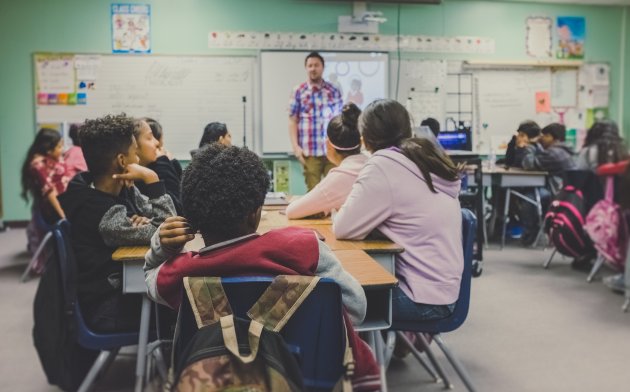How innovative technology is enhancing the way we teach and learn
More and more technology is entering the classroom – and it's making for better teachers and more engaged students.

May 9, 2023
Technology in the classroom has long been a contentious topic. There is a common view that students are already spending too much time on games, smartphones, and social media, so it might be wise to keep gadgets out of the classroom and stick to tried and tested teaching methods.
Historically, there has also been pushback from the teachers – integrating technologies in the classroom can complicate the teaching experience, distract students, and add extra overhead to already-overburdened staff.
But what if these gadgets and educational tools make for a better learning AND teaching experience?
Even before the pandemic, there was a steady rise in interest in classroom technologies, as blended learning began gaining traction, and smartboards increasingly made their way into classrooms around the world. But it's the pandemic that kicked digital transformation into a new gear, forcing remote and hybrid forms of study and demanding the use of technology to provide students with a holistic learning experience.
Now, with teachers growing better acquainted with educational technology, they're starting to better understand the benefits it offers. Experts have been saying it for years – used the right way, technology can enhance learning. And it's not just the students benefiting, but teachers, too.
Let's dive deeper into how innovative technology helps teachers create a more productive and effective learning environment and what students gain from it.
Helping teachers overcome classroom challenges
Ask any teacher what their biggest classroom challenges are, and they’re bound to mention at least one (and probably several) of the following:
- Students who are easily bored and distracted – nowadays even the youngest students have pocket devices that can distract them from class. This is particularly troublesome in remote scenarios.
- Managing conflicting personalities – teachers must reach extroverts and introverts, diligent students and back-of-the-classroom troublemakers, which can complicate lesson pace, among other things.
- Keeping large classes in check – encouraging participation from everyone, being mindful of different learning levels, and having to constantly think of new ways to keep the students engaged and motivated.
- Staying on top of paperwork – both in terms of managing tests, materials, and reports, as well as ensuring lesson plans adhere to the broader curriculum.
Smart technology adds a new dimension to traditional teaching methods, which, in turn, may help teachers better grapple with the challenges above and more. Let's take a look at four concrete examples of how it can do that.
4 ways how technology can enhance the classroom experience for students
As tech in the classroom becomes ubiquitous, existing solutions have focused on making it easy to implement – both hardware and software. This means that, today more than ever before, it's painless to get started with tech for education. And here are four ways how it can make you a better teacher in this day and age.
1. Show, don't tell – easily
Tools such as screencasts and smartboards dramatically simplify and visually enhance the “show, don't tell” approach for teachers. Using this tech makes it easier to explain complex topics such as a difficult math problem or a literacy activity because the use of visuals helps students absorb information and understand a topic more quickly and deeply.
Moreover, there is a trove of teaching materials available online, which allows teachers to tap into and easily share existing educational content and explainers with their students, without having to design additional content themselves.

2. Giving students cognitive choices
Interactive technology and devices encourage autonomy and responsibility, as well as teach students to familiarize themselves with using tech productively in their day-to-day – an invaluable skill in the modern world. When students have more control over their learning and decision making, they become more motivated and invested in the learning process.
For example, letting students research and present topics is a common way how to engage them in group work and skill development, but it's rarely met with unbridled enthusiasm. That is – until you introduce technology. A handful of laptops and an internet connection (or a drive with pre-selected and approved information) is the fastest way to get everyone excited and on board.
Proactive, collaborative learning also moves the teacher away from the front of the classroom and allows them to take on a more advisory role.
3. Providing additional support to those who need it
Apps and software programs can also be used to address the individual needs of students at different stages of learning. This is particularly beneficial at the elementary stage, where smaller schools often combine their year levels. Younger learners are fascinated by gadgets and devices. So, tablets, apps, software programs, and interactive tools can be used in an educational setting to enhance their language and literacy skills while helping teachers respond to the individual needs of each child.
Gamification often comes hand-in-hand with educational software, and the benefits are undeniable – students score 14 percent higher in assessments upon the addition of gamified elements.
4. It’s fun and fosters collaboration
Technology helps break down the barriers of formal, authoritarian learning. Students respond far more positively in a relaxed, enjoyable learning environment. Research shows that younger children, in particular, learn better and are much more able to solve logical problems through play.
Catchbox is a perfect example of how technology can be used to bring fun and collaboration into the classroom. The soft, throwable microphone adds a whole new dimension to group activities such as discussions, debates, and in-class games. It encourages participation and helps shy students come out of their shells. See for yourself!
Technology in special needs education
Technology can go a long way toward helping students with learning disabilities bridge the gap and level the playing field with their peers while increasing their autonomy.
Touchscreen tablets are easy to use for students with various types of motor skill difficulties and cognitive challenges. They’re also a great alternative as a communication tool for students with verbal challenges. And they can provide additional reading and writing support for those with dyslexia. Tablets and smart apps have been shown to be particularly beneficial as educational aids for students with autism and ASD.
Special needs education students were among the worst affected by the pandemic, as the infrastructure simply wasn't there to ensure adequate remote experiences. For example – how would a hard-of-hearing student that relies on lip-reading participate remotely in their hybrid classes when the in-person teacher and students must all wear masks?
In this particular scenario, a solution was concocted using a Catchbox in-class to be passed to whoever's speaking and relying on the Google Meets auto-caption feature to transcribe what's being said to the remote, hard-of-hearing student. Still, getting to such a solution took months, during which the student experienced difficulties keeping up with class.
The frustration of not being able to communicate effectively is unfair and undermines the entire learning experience. Tablets, smart apps, microphones, and other technology can help students express themselves and verbalize their thoughts and feelings – or even simply participate in class. They can also encourage them to interact and collaborate more readily in a group setting.
It’s not just for the kids – edTech can benefit teachers, too
Teachers often complain that they’re spending more and more time on paperwork and lesson planning than on actual teaching. Technology such as time-saving software tools and programs can really come in handy here, allowing teachers to create and manage lesson plans more easily while automating tiresome, time-consuming tasks. In addition, tracking tools can help them monitor students’ progress, create and grade assignments and even enhance their own professional development.
Organized meetings are an essential part of staff-parent communication. But not everybody gets the chance to voice their ideas, opinions, or concerns.
Here again, technology such as Catchbox can help. Take it along to the next staff or parents’ meeting, pass it around or toss it into the audience for a spontaneous Q&A session. It’s a great way to break the ice, create a more relaxed and informal setting and give everyone an opportunity to have a say, which in turn will lead to a more productive meeting.
Wrapping up
It's not an either-or decision between traditional teaching and tech-enhanced teaching. You don't have to completely revamp your lesson plans or pack the classroom with complex tech. Rather, find the tools that help you do your job best and students respond well to. And integrate it incrementally.
Used correctly, technology can greatly enhance the way we teach and learn. There is a cottage industry of tools and software that can do everything from digitizing entire lesson plans to simply offering a more engaging way to deliver a topic.
At the end of the day, by embracing technology, you’ll be taking a positive step forward toward a happier, more enjoyable, and more effective learning environment for students of all ages and abilities.
Recommended
Find out more

Kyrene Traditional Academy case study
Many schools all over the world are struggling with the same issues – constantly adapting to ever-changing requirements, students being in and out of class at the first signs of any COVID-19 symptoms, and kids falling behind on their education.

Catchbox for education
Create more immersive learning experiences with Catchbox microphones. Ensure both teachers and students can be heard in the classroom and encourage participation across a range of educational settings.